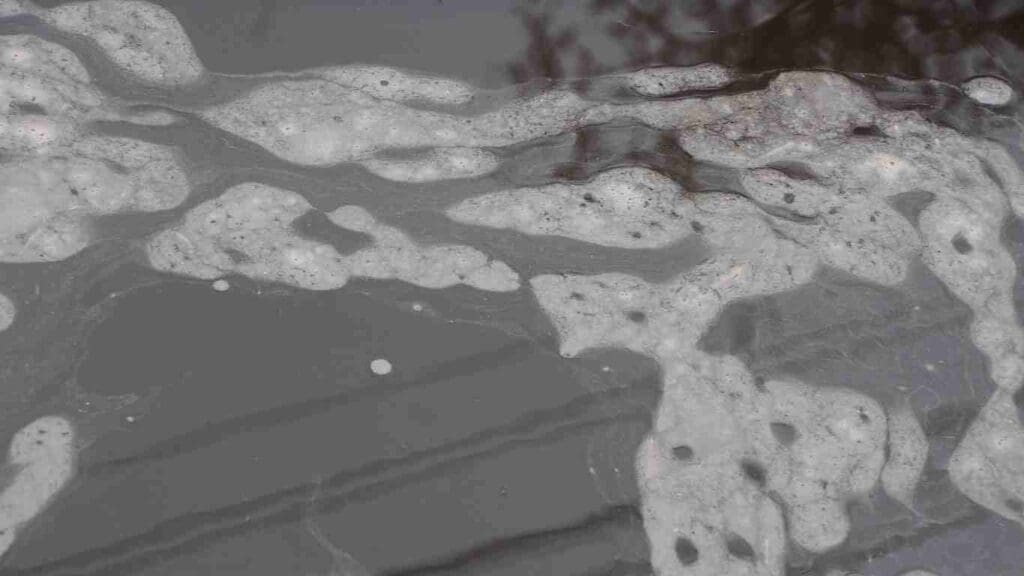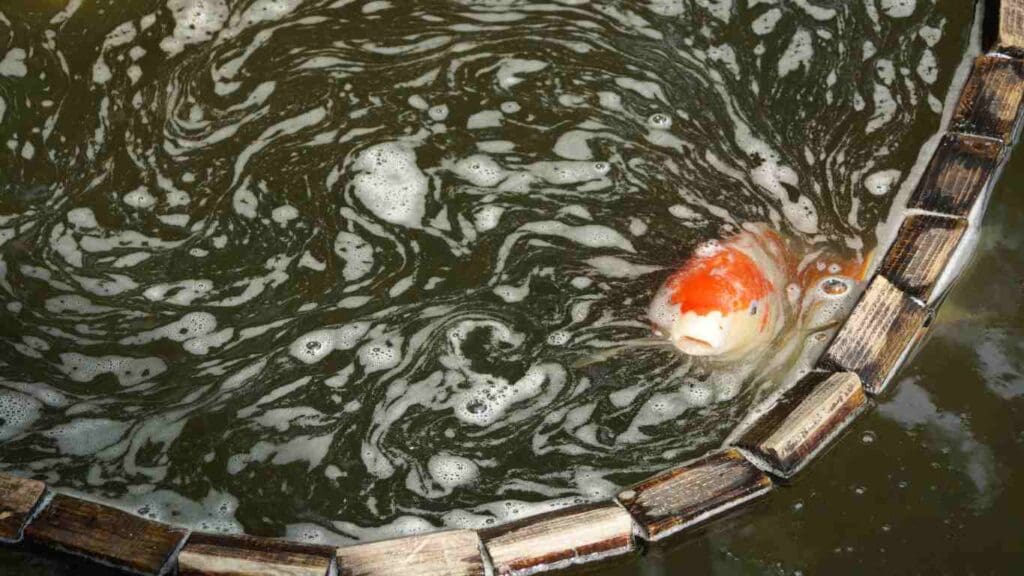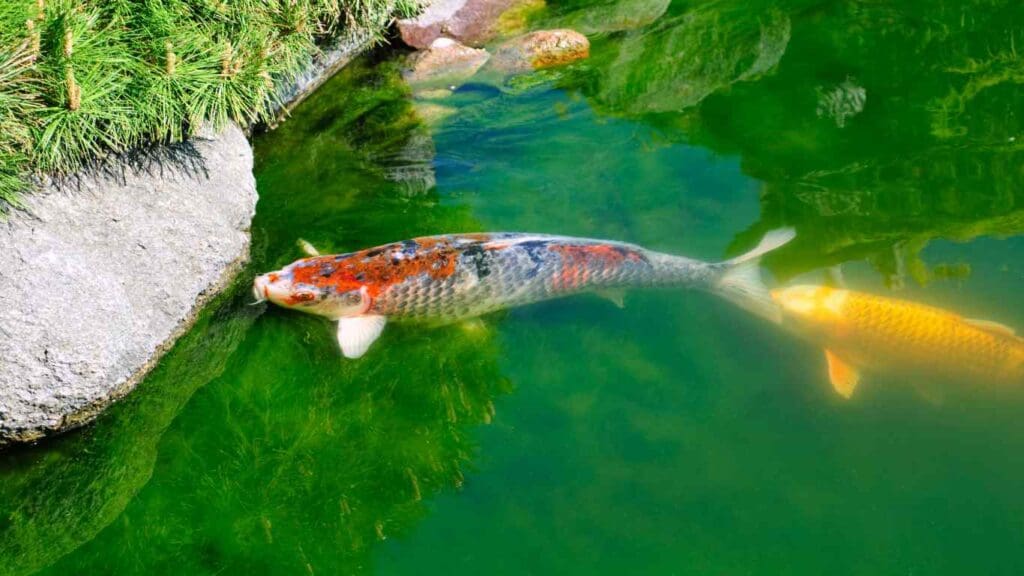If you have noticed foam accumulating in your koi pond, you may be wondering what is causing it and how to get rid of it. Foam buildup can be unsightly and may indicate an underlying issue with your pond’s water quality. Luckily, there are several steps you can take to prevent and eliminate foam buildup in your koi pond. For detailed guidance, you might want to refer to the article titled ‘How to Get Rid of Foam in Your Koi Pond’.
One of the most common causes of foam in a koi pond is organic debris breaking down in the water. This debris can come from a variety of sources, including leaves, pine needles, fish waste, uneaten food, and fish spawning. Additionally, poor water circulation and filtration can contribute to foam buildup. By taking steps to address these underlying issues, you can help prevent foam from accumulating in your pond in the first place.
How to Get Rid of Foam in Your Koi Pond- Key Takeaways
When it comes to getting rid of foam in your koi pond, there are a few key takeaways to keep in mind:
By following these tips and taking a proactive approach to pond maintenance, you can keep your koi pond free of foam and ensure a healthy environment for your fish to thrive in. Remember to regularly monitor your pond’s water quality and make adjustments as needed to keep your pond looking and feeling its best.
Causes of Foam
If you have noticed foam in your koi pond, it is important to understand the possible causes so that you can take appropriate steps to fix the problem. Here are some common reasons why foam may appear in your koi pond:
Poor Water Quality
One of the primary causes of foam in a koi pond is poor water quality. This can occur due to a lack of proper filtration or when there is an excess of nutrients and fertilizers in the water. When there is an abundance of waste in the pond, it can cause foam to form on the surface.


Changes in Water Quality
If you have recently made changes to your pond, such as adding new plants or fish, it can lead to changes in water quality. These changes can cause foam to form on the surface of the pond.
Spawning/Breeding
Another reason why foam may appear in your koi pond is due to spawning or breeding. During this process, koi fish will create strong currents in the water, which can break the surface tension and cause foam to form.
It is important to identify the cause of the foam in your koi pond so that you can take appropriate steps to fix the problem. By addressing the underlying issue, you can help ensure that your koi pond remains healthy and free of foam.
Understanding Foam in Koi Ponds
If you have a koi pond, you may have noticed foam or bubbles on the surface of the water. This can be concerning, but it’s important to understand the causes and impacts of foam in your pond.
Impacts of Foam on Koi Health
While foam itself is not harmful to koi, it can be a sign of underlying issues in your pond. Excess foam can indicate high levels of organic matter, such as uneaten food or fish waste, which can lead to poor water quality and potentially harm your koi’s health.


Additionally, foam can create a barrier on the surface of the water, preventing oxygen exchange and making it harder for your koi to breathe. This can be especially problematic during hot summer months when oxygen levels in the water may already be low.
To ensure the health and well-being of your koi, it’s important to address any foam issues in your pond. In the next section, we’ll explore some common causes of foam and how to fix them.
Preventive Measures
To prevent foam buildup in your koi pond, there are a few preventive measures you can take. These measures include proper feeding practices and regular pond maintenance.
Proper Feeding Practices
One of the main causes of foam buildup in koi ponds is overfeeding. To prevent this, it is important to feed your koi the right amount of food. You should only feed your koi what they can eat within 5 minutes. If there is any uneaten food, remove it immediately to prevent it from decomposing and causing foam buildup.
Additionally, it is important to feed your koi a high-quality food that is appropriate for their size and age. Avoid feeding them low-quality food or food that contains fillers, as this can contribute to poor water quality and foam buildup.


Regular Pond Maintenance
Another important preventive measure is regular pond maintenance. This includes regular water changes, checking and cleaning your pond filter, and removing any debris or dead plant matter from your pond.
It is recommended to do a 10-20% water change every week to maintain good water quality. This will help remove any excess nutrients that can contribute to foam buildup.
Cleaning your pond filter regularly is also important to ensure that it is working properly and not contributing to foam buildup. You should also remove any debris or dead plant matter from your pond as soon as possible to prevent it from decomposing and causing foam buildup.
By following these preventive measures, you can significantly reduce the likelihood of foam buildup in your koi pond.
Methods to Remove Existing Foam
If you have already noticed foam in your koi pond, you need to take immediate action to remove it. Here are some effective methods to get rid of the foam in your pond.
Manual Removal
The fastest way to remove foam from your pond is to skim the surface with a net or skimmer. Simply scoop out the visible bubbles and dispose of them properly. This method is effective for small amounts of foam, but it may not be enough for larger amounts.
Using Defoaming Agents
Defoaming agents are chemicals that break down the foam in your pond. You can find these agents in liquid or powder form at your local pond supply store. Follow the instructions carefully when using these agents, as using too much can harm your fish and plants.
Removes Foam from Your Koi Pond
Installing Foam Fractionators
Foam fractionators, also known as protein skimmers, are devices that remove organic matter from your pond. They work by creating a column of air bubbles that attract and remove the foam. These devices are effective for larger ponds with significant foam buildup.
It is important to note that while these methods can help remove foam from your pond, they do not address the underlying causes of foam buildup. To prevent future foam issues, you should regularly clean your pond, reduce the fish load, and check your filtration system.


Long-Term Solutions
Improving Water Quality
One of the main causes of foam in a koi pond is poor water quality. To prevent foam buildup in the long-term, you need to improve the quality of the water in your pond. This can be achieved by implementing the following measures:
- Regular Water Changes: Regular water changes can help to reduce the concentration of organic matter in the water, which can contribute to foam buildup. Aim to change at least 10% of the water in your pond every week.
- Maintain Proper Filtration: Make sure your filtration system is working properly and is appropriately sized for your pond. This will help to remove excess nutrients and organic matter from the water.
- Reduce Fish Load: Overcrowding your pond with too many fish can contribute to poor water quality and foam buildup. Make sure you have an appropriate number of fish for the size of your pond.
Balancing Pond Ecosystem
Another way to prevent foam buildup in the long-term is to balance the ecosystem of your pond. This can be achieved by implementing the following measures:
- Reduce Feeding: Overfeeding your fish can contribute to excess nutrients in the water, which can lead to foam buildup. Feed your fish only what they can consume within a few minutes.
- Add Plants: Adding plants to your pond can help to absorb excess nutrients and organic matter from the water. Make sure to choose plants that are appropriate for your pond size and climate.
- Increase Aeration: Increasing aeration can help to break down organic matter more quickly and prevent it from accumulating on the surface of the water. Consider adding an air pump or a fountain to your pond to increase aeration.
By implementing these long-term solutions, you can prevent foam buildup in your koi pond and maintain a healthy ecosystem for your fish.


Join Us and Get a FREE eBook with Everything You Need to Know to Build Your Koi Pond
Final Remarks
In the end, getting rid of foam in your koi pond can be a challenging task, but it is not impossible. By understanding the causes of foam buildup and taking appropriate measures to prevent it, you can maintain a healthy and clear pond for your koi fish.
Regular water changes, using de-foaming agents, reducing the fish load, and checking filtration are effective ways to prevent foam buildup. Additionally, reducing the amount of meals and removing any dead fish or organic material from the pond can also help.
It is crucial to test your pond water regularly for ammonia, nitrites, and nitrates to ensure that there are no serious issues with your pond. If you notice any unusual changes in your pond, such as foam buildup or changes in water clarity, take action immediately.
Remember to always use caution when adding any chemicals to your pond and follow the manufacturer’s instructions carefully. With proper care and maintenance, you can enjoy a beautiful and healthy koi pond free of foam buildup.
Frequently Asked Questions
How can I prevent foam from forming in my koi pond?
To prevent foam from forming in your koi pond, you can take several steps. First, make sure to perform regular water changes to keep the water quality in check. Second, avoid overfeeding your fish, as excess food and waste can contribute to foam formation. Third, make sure to properly maintain your filtration system to ensure it is working efficiently.
What are some effective homemade remedies for removing foam from my pond?
Some effective homemade remedies for removing foam from your pond include adding barley straw, using baking soda, and adding a small amount of vinegar to the water. However, it is important to note that these remedies may not work for all cases of foam formation and should be used with caution.
Is it safe for my fish to use pond foam remover?
Most pond foam removers are safe for fish when used as directed. However, it is important to read the instructions carefully and follow them closely to avoid harming your fish or other aquatic life in your pond.
What is a foam fractionator and how can it help with foam in my koi pond?
A foam fractionator, also known as a protein skimmer, is a device that removes organic waste from the water by creating a foam that collects the waste particles. This can help to reduce foam formation in your koi pond by removing the substances that contribute to foam.
Why does my koi pond foam up during spawning season?
Koi fish produce a lot of mucus during spawning season, which can contribute to foam formation in the pond. Additionally, the increased activity and movement of the fish during this time can also cause more agitation in the water, leading to increased foam.
What are some common causes of excessive foam in my pond?
Some common causes of excessive foam in your pond include poor water quality, overfeeding your fish, using too much fertilizer, and having too many fish in your pond. It is important to identify the underlying cause of the foam formation in order to effectively treat and prevent it in the future.
 1 (509) 228-8646
1 (509) 228-8646




